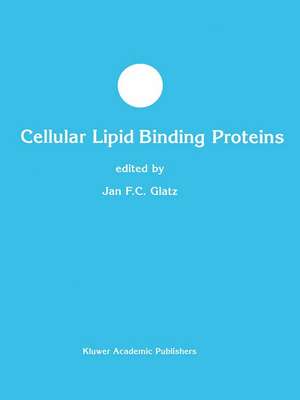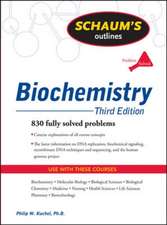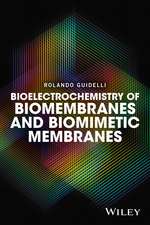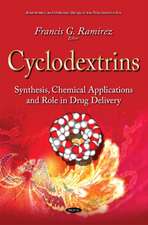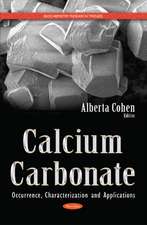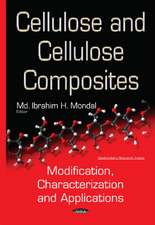Cellular Lipid Binding Proteins: Developments in Molecular and Cellular Biochemistry, cartea 38
Editat de Jan Jansenen Limba Engleză Paperback – 5 noi 2012
| Toate formatele și edițiile | Preț | Express |
|---|---|---|
| Paperback (1) | 942.72 lei 6-8 săpt. | |
| Springer Us – 5 noi 2012 | 942.72 lei 6-8 săpt. | |
| Hardback (1) | 811.80 lei 38-44 zile | |
| Springer Us – 30 noi 2002 | 811.80 lei 38-44 zile |
Din seria Developments in Molecular and Cellular Biochemistry
- 5%
 Preț: 386.34 lei
Preț: 386.34 lei - 24%
 Preț: 1056.97 lei
Preț: 1056.97 lei - 18%
 Preț: 1214.67 lei
Preț: 1214.67 lei - 24%
 Preț: 1060.04 lei
Preț: 1060.04 lei -
 Preț: 401.33 lei
Preț: 401.33 lei - 5%
 Preț: 368.58 lei
Preț: 368.58 lei - 18%
 Preț: 1544.04 lei
Preț: 1544.04 lei - 5%
 Preț: 729.17 lei
Preț: 729.17 lei - 24%
 Preț: 1568.12 lei
Preț: 1568.12 lei - 24%
 Preț: 1580.08 lei
Preț: 1580.08 lei - 24%
 Preț: 1584.02 lei
Preț: 1584.02 lei - 5%
 Preț: 362.94 lei
Preț: 362.94 lei - 24%
 Preț: 1564.06 lei
Preț: 1564.06 lei - 24%
 Preț: 1077.72 lei
Preț: 1077.72 lei - 15%
 Preț: 578.31 lei
Preț: 578.31 lei - 24%
 Preț: 1583.80 lei
Preț: 1583.80 lei - 5%
 Preț: 666.31 lei
Preț: 666.31 lei - 18%
 Preț: 1213.60 lei
Preț: 1213.60 lei - 24%
 Preț: 801.38 lei
Preț: 801.38 lei - 24%
 Preț: 1098.57 lei
Preț: 1098.57 lei - 18%
 Preț: 933.16 lei
Preț: 933.16 lei - 24%
 Preț: 1060.10 lei
Preț: 1060.10 lei - 5%
 Preț: 1003.85 lei
Preț: 1003.85 lei - 18%
 Preț: 928.77 lei
Preț: 928.77 lei - 5%
 Preț: 1408.00 lei
Preț: 1408.00 lei - 24%
 Preț: 795.19 lei
Preț: 795.19 lei - 18%
 Preț: 940.19 lei
Preț: 940.19 lei - 15%
 Preț: 638.28 lei
Preț: 638.28 lei - 24%
 Preț: 808.09 lei
Preț: 808.09 lei - 18%
 Preț: 944.27 lei
Preț: 944.27 lei
Preț: 942.72 lei
Preț vechi: 1149.66 lei
-18% Nou
Puncte Express: 1414
Preț estimativ în valută:
180.55€ • 186.02$ • 151.24£
180.55€ • 186.02$ • 151.24£
Carte tipărită la comandă
Livrare economică 22 februarie-08 martie
Preluare comenzi: 021 569.72.76
Specificații
ISBN-13: 9781461348689
ISBN-10: 1461348684
Pagini: 248
Ilustrații: 237 p.
Dimensiuni: 210 x 280 x 13 mm
Greutate: 0.57 kg
Ediția:2002
Editura: Springer Us
Colecția Springer
Seria Developments in Molecular and Cellular Biochemistry
Locul publicării:New York, NY, United States
ISBN-10: 1461348684
Pagini: 248
Ilustrații: 237 p.
Dimensiuni: 210 x 280 x 13 mm
Greutate: 0.57 kg
Ediția:2002
Editura: Springer Us
Colecția Springer
Seria Developments in Molecular and Cellular Biochemistry
Locul publicării:New York, NY, United States
Public țintă
ResearchCuprins
Cellular lipid binding proteins as facilitators and regulators of lipid metabolism.- Critical steps in cellular fatty acid uptake and utilization.- Mechanism of cellular uptake of long-chain fatty acids: Do we need cellular proteins?.- Similar mechanisms of fatty acid transfer from human anal rodent fatty acid-hinding proteins to membranes: Liver, intestine, heart muscle, and adipose tissue FABPs.- Cytosolic fatty acid binding proteins catalyze two distinct steps in intracellular transport of their ligands.- Insights into binding of fatty acids by fatty acid binding proteins.- The effect of charge reversal mutations in the ?-helical region of liver fatty acid binding protein on the binding of fatty-acyl CoAs, lysophospholipids and bile acids.- Solution structure of fatty acid-binding protein from human brain.- Evolution of the family of intracellular lipid binding proteins in vertebrates.- Intracellular lipid binding proteins of the small intestine.- Analysis on the phenotype of E-FABP-gene knockout mice.- Sterol carrier protein-2: Not just for cholesterol any more.- Fatty acid binding protein expression in different human adipose tissue depots in relation to rates of lipolysis and insulin concentration in obese individuals.- Protein acylation in the cardiac muscle like cell line, H9c2.- Alternative lipid mobilization: The insect shuttle system.- Giant membrane vesicles as a model to study cellular substrate uptake dissected from metabolism.- Peroxisomc proliferator-activated receptors: Lipid binding proteins controlling gene expression.- New insights into the fatty acid-binding protein (FABP) family in the small intestine.- Regulation of the ileal bile acid-binding protein gene: An approach to determine its physiological function(s).- Role of adipocyte lipid-bindingprotein (ALBP) and acyl-CoA binding protein (ACBP) in PPAR-mediated transactivation.- Analysis of tissue-specific and PPAR?-dependent induction of FABP gene expression in the mouse liver by an in vivo DNA electroporation method.- Characterization of a new fatty acid response element that controls the expression of the locust muscle FABP gene.- Regulation of fatty acid transport and membrane transporters in health and disease.- The impact of overexpression and deficiency of fatty acid translocase (FAT)/CD36.- Intestinal lipid absorption is not affected in CD36 deficient mice.- Surface expression of fatty acid translocase (FAT/CD36) on platelets in myeloproliferative disorders and non-insulin dependent diabetes mellitus: Effect on arachidonic acid uptake.- Sulfo-.V-succinimidyl esters of long chain fatty acids specifically inhibit fatty acid translocase (FAT/CD36)-mcdiated cellular fatty acid uptake.- Ex-FABP, extracellular fatty acid binding protein, is a stress lipocalin expressed during chicken embryo development.- Plasma concentration of intestinal- and liver- FABP in neonates suffering from nccrotizing cnterocolitis and in healthy preterm neonates.- 235-237.
